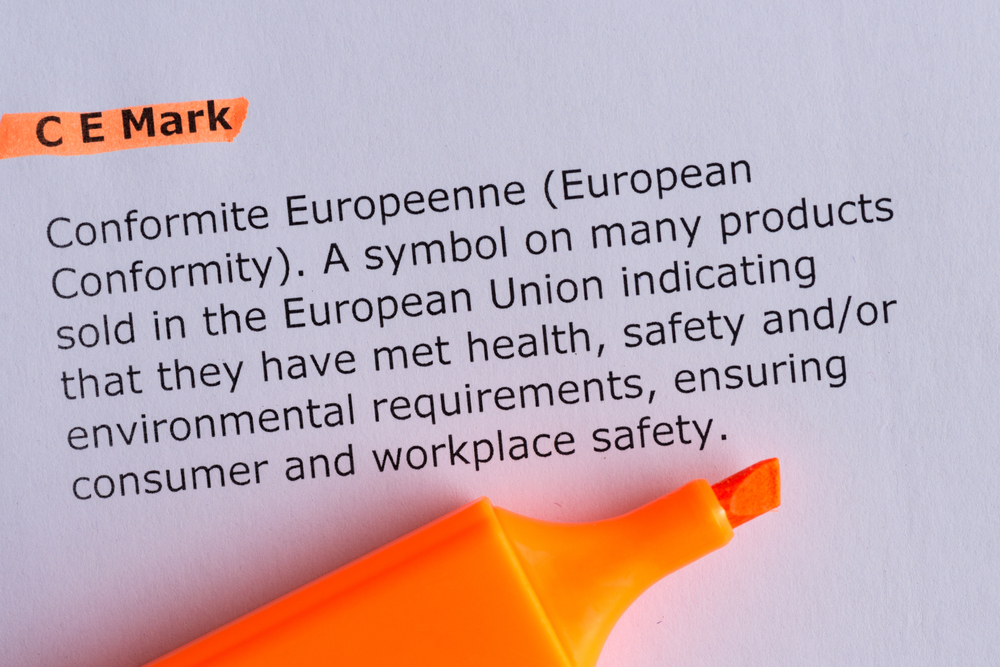CE/UKCA Mark Quick Topics
What is a CE Mark?
The CE Mark is a generic product compliance mark. used and legally recognized by the twenty-seven European Union (EU) countries, the three European Free Trade Area (EFTA) countries and Switzerland.
The letters ‘CE’ are an abbreviation of the French words “Conformité Européenne”, which means European conformity. The CE Marking is a mandatory European marking for a wide range of products indicating conformity with the essential requirements of applicable European Directives.
What is a UKCA Mark?
The UKCA Mark is a generic product compliance mark that only applies to products placed on the market in Great Britain. In Northern Ireland, which remains aligned to the European Single Market due to the Northern Ireland Protocol, CE marking continues to be required.
The UK Conformity Assessed (UKCA) Marking is mandatory in the United Kingdom for a wide range of products indicating conformity with the essential requirements of applicable GB standards.
Why would you need a CE or UKCA Mark Evaluation?
To legally market products to Europe, a CE Marking on the product and a Declaration of Conformity (to the applicable
Directives) is required for CE compliance. In addition, a Technical File, substantiating conformity, must be made available upon a duly
reasoned request by competent national authorities.
The need for CE Marking to be performed on equipment being shipped to or soon-to-be operated in the EEA
is defined as according to the European Commission’s website:
By affixing the CE marking to a product, a manufacturer declares that the product meets all the legal requirements for
CE marking and can be sold throughout the EEA. This also applies to products made in other countries that are
sold in the EEA.There are two main benefits CE certification brings to businesses and consumers within the EEA:
Businesses know that products bearing the CE marking can be traded in the EEA without restrictions.
Consumers enjoy the same level of health, safety, and environmental protection throughout the entire EEA.
To legally market products to the United Kingdom, a UKCA Marking on the product and a Declaration of Conformity (to the applicable Directives) is required. In addition, a Technical File, substantiating conformity, must be made available upon a duly
reasoned request by competent national authorities.
The need for a UKCA Mark evaluation to be performed on equipment being shipped to or soon-to-be operated in the UK
is defined as according to the UK Government’s website:
UK conformity assessment (UKCA) marking is used on products placed on the market in Great Britain (GB). It shows that products comply with requirements in legislation applying in GB. The UKCA marking does not apply in the Crown Dependencies: the Isle of Man, Guernsey and Jersey. The UKCA marking does not apply in the British Overseas Territories.
What will and should be considered in a CE/UKCA evaluation?
For CE Marking in the European Union a CE Mark evaluation is usually comprised of the following three directives:
- Low Voltage Directive (LVD) – [2014/35/EU] Machinery operating on 50 to 1000 VAC or 75 to 1500 VDC.
- Machinery Directive (MD) – [2006/42/EC] Machinery with driving parts and components such as solenoid valves are not subject to the CE marking requirement, but having those components certified to the EU standard helps towards gaining CE marking approval for the end-products.
- Electromagnetic Compatibility Directive (EMC) – [2014/30/EU] Components that emit electromagnetic interference waves or are influenced by electromagnetic interference waves and solenoid valves consisting of simple solenoids are not subject to the CE marking requirement, but having those components certified to the EU standard helps towards gaining CE marking approval for the end-products.
Important note: EMC testing is a mandatory guideline for any equipment involving electronics. For more information specifically concerning this directive, please consult the EU Electromagnetic Compatibility Directive (EMC) guidelines here. This official EU website states that:
All electric devices or installations influence each other when interconnected or close to each other, e.g. interference between TV sets, GSM handsets, radios and nearby washing machine or electrical power lines. The purpose of electromagnetic compatibility (EMC) is to keep all those side effects under reasonable control. EMC designates all the existing and future techniques and technologies for reducing disturbance and enhancing immunity.
The Electromagnetic Compatibility Directive (EMCD) ensures that electrical and electronic equipment does not generate, or is not affected by, electromagnetic disturbance.
Other CE Mark Directives may also apply:
Your product must be evaluated by our engineering team to determine which specific additional CE Directives are applicable to your product.
The list that follows covers some additional directives that may apply to your specific product to ensure full CE compliance in the EU:
- Explosive Atmospheres Directive (ATEX)
- Pressure Equipment Directive (PED)
- Radio Equipment Directive
- RoHS Directive
- Medical Devices Directive
- Important note: Lewis Bass cannot support this Directive. It requires a notified body solely specializing in medical device certification.
For UKCA Marking in the United Kingdom a UKCA Mark evaluation is usually comprised of the following three directives:
- Low Voltage Directive (LVD) – The Electrical Equipment (Safety) Regulations 2016 Low Voltage Directive.
- Machinery Directive (MD) – Supply of Machinery (Safety) Regulations 2008 Machinery Directive essential health and safety requirements.
- Electromagnetic Compatibility Directive (EMC) – [2014/30/EU] – Subject to the UK’s statutory guidance, Electromagnetic Compatibility Regulations 2016: Great Britain the UK still recognizes the EU’s EMC 2014/30/EU Directive in UK law as of 2016 and states under section 2, Legislative Background that:
The Electromagnetic Compatibility Regulations 2016 implements into UK law an EU Directive (2014/30/EU) on electromagnetic compatibility (commonly called the EMC Directive). The EU Withdrawal Act 2018 preserved the Regulations and enabled them to be amended so as to continue to function effectively now that the UK has left the EU. Accordingly, the Product Safety and Metrology etc. (Amendment etc.) (EU Exit) Regulations 2019 see footnote 1 fixed any deficiencies that arose from the UK leaving the EU (such as references to EU institutions) and made specific provision for the GB market.
There is therefore one set of UK 2016 Regulations, but some of the provisions apply differently in NI under the terms of the Windsor Framework. References to the 2016 Regulations in this guidance are references to those Regulations as they apply in Great Britain.
CE/UKCA Mark addendum reports: when do they apply?
CE or UKCA Mark addendum reports are a clear, simpler path forward over a full CE or UKCA report. These addendum reports are specifically drafted in situations where previously evaluated systems have received minimal revisions due to either parts scarcity, redesigns specified by the end user, name changes, or other functional adjustments, ex: adding a different type of sub-assembly like a chiller or heating element.
For situations where minimal changes have been made to the system:
CE or UKCA Mark addendum reports performed on systems that have been previously evaluated for compliance to CE or UKCA Mark Directives are evaluated against the changes in the BOM, schematics, and provided documentation for the modified system.
The resulting CE or UKCA Mark addendum report provides the delta of the changes in the system which can then be outlined and noted in the addendum report along with supporting verbiage stating that the modifications are still within the acceptable ranges of conformity per each CE or UKCA Mark Directive it was evaluated against. A Lewis Bass engineer may also request additional supporting documentation for hardware-level modifications or additional sub-systems that were added to the new design to ensure these modifications and sub-systems are listed components and are safe to be included in the design.
As of June 26th 2024, Lewis Bass now offers CE Mark Addendum Reports as a service to our clients. If you would like a quote for this service, please click this link here to request a quote.
What is the process for performing a CE/UKCA Mark?
As a general guideline, our engineer will perform the following tasks in coordination with your engineering team
below:
1) Review the machine’s manuals, BOM (Bill of Materials), and schematics.
2) Come to your facility and do a multi-day inspection.
3) Provide your team with a punchlist of items that failed.
4) Communicate back and forth with you to resolve all identified issues.
5) Start writing the report and putting together the Technical File.
6) Produce a draft report for your to review and make requests.
7) Provide the final report and technical file.
8) Sign the CE or UKCA Declaration of Conformity for your equipment.
The European Commission: Defining CE Marking
The Conformité Européene (CE) Mark is defined as the European Union’s (EU) mandatory conformity marking for regulating the goods sold within the European Economic Area (EEA) since 1985. The CE marking represents a manufacturer’s declaration that products comply with the EU’s New Approach Directives. These directives not only apply to products within the EU but also for products that are manufactured in or designed to be sold in the EEA. This makes the CE marking recognizable worldwide even to those unfamiliar with the EEA.
Per the European Union’s website:
When you buy a new phone, a teddy bear, or a TV within the EEA, you can find the CE mark on them. CE marking also supports fair competition by holding all companies accountable to the same rules.
By affixing the CE marking to a product, a manufacturer declares that the product meets all the legal requirements for CE marking and can be sold throughout the EEA. This also applies to products made in other countries that are sold in the EEA.
CE marking is a part of the EU’s harmonisation legislation, which is mainly managed by Directorate-General for Internal market, Industry, Entrepreneurship and SMEs. The CE marking for Restriction of Hazardous Substances is managed by Directorate-General for Environment. Comprehensive guidance on the implementation of EU product rules can be found in the so-called Blue Guide.
The Department for Business and Trade: Defining UKCA Marking
About the UK’s Department for Business and Trade per their website:
We are the department for economic growth. We support businesses to invest, grow and export, creating jobs and opportunities across the country. DBT is a ministerial department, supported by 20 agencies and public bodies.
About the UK’s Department for Business and Trade per their Wikipedia article:
The Department for Business and Trade (DBT)[1] is a ministerial department of the Government of the United Kingdom. It was established on 7 February 2023 by a cabinet reshuffle under the Rishi Sunak premiership. The new department absorbed the functions of the former Department for International Trade and some of the functions of the former Department for Business, Energy, and Industrial Strategy.
The department is headed by the Secretary of State for Business and Trade, assisted by a number of junior ministers. The incumbent and the first to hold the role is Kemi Badenoch.
December 31st 2020: The Arrival of the UKCA Mark
Per Wikipedia’s article on UKCA Marking:
The UKCA marking became part of UK law at the end of the Brexit transition period, on 31 December 2020, with the coming into force of The Product Safety and Metrology etc. (Amendment etc.) (EU Exit) Regulations 2019. The scope and procedures of the UKCA scheme initially follow those for CE marking. The Government said that after 31 December 2020 the two schemes may diverge.[6] Initial guidance regarding UKCA marking was originally published by the Government of the United Kingdom in 2019.
CE/UKCA Mark Resources
Do you need a simple straight-to-the-point document covering CE Marking and the process involved? Download our CE Mark marketing cutsheet flyer here.
Otherwise known as Annex B of the IEC 60204-1:2016, this helpful document provides a handy checklist to go over for preparation ahead of a CE Mark evaluation. Even though it is IEC 60204-1 specific, the checklist is readily applicable to most every Directive in CE Marking when it comes to project readiness analysis. Download it here.




